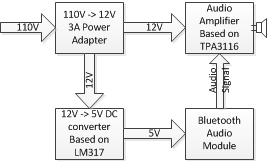I am building a Bluetooth Speaker and I been getting static noise or high pitch tone with certain configuration. I am new to electronics, hopefully the seasoned hobbyists here can help me explain what I am observing.
I initially build the speaker with the following configuration:

I am experiencing static noise and high pitch tone with this configuration. At first I thought it's due to the 12V->5V step down converter I built, so I replaced that with a off the shelf USB Auto Charger (the one that plugs into the 12V outlet in car and powers a USB port) but still experience the same issue.
Later, during some trial and error I came across the following configuration:

With this configuration, where 5V is coming directly from a cellphone charger, the static noise and the high pitch tone are gone. Everything is working as I expected it would except the fact that I have two power adapters powering one project.
I did some research and came across this post by Jake, I believe we ran into the exact problem. It seems to be resolved through the use of ground loop isolator. I read up on the ground loop and how an isolator can address the issue but couldn't get a good understanding of it. So here are my questions:
- What is ground loop?
- How can I solve the problem I am having without a ground loop isolator?
Thanks in advance for the advise.
